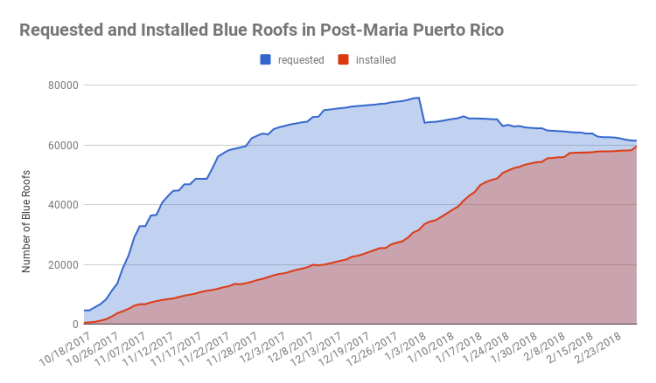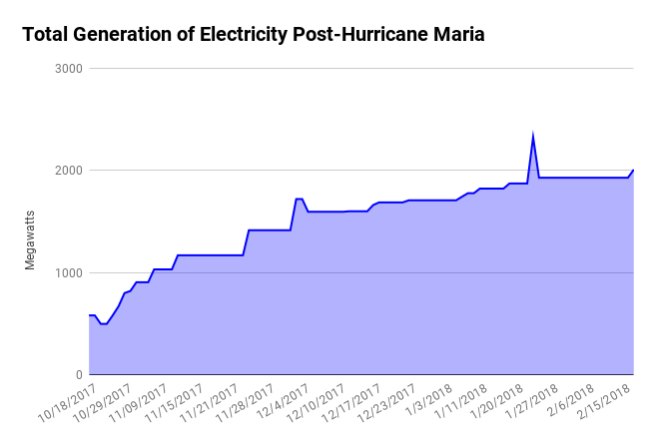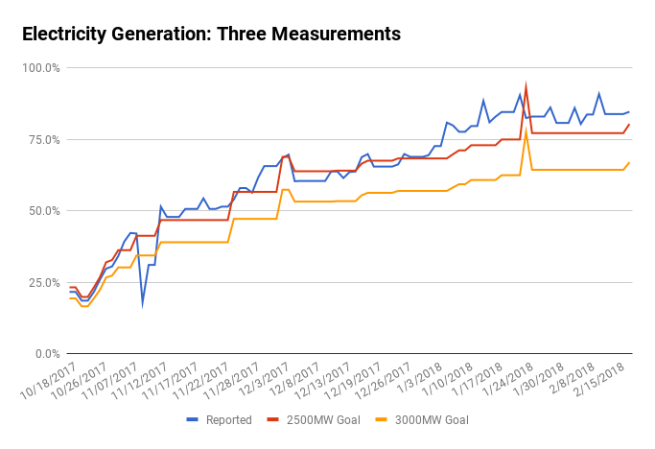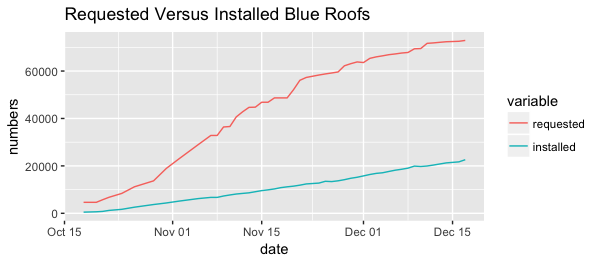BACKGROUND NOTE: In a previous post, titled “The Risk of Unrealistic Expectations”, I examine why restoring electricity to the island has been so slow. Since then, I have been researching this issue and it is now part of a wider academic project examining U.S.-Puerto Rico relations after Hurricane Maria. In this post, I focus on Governor Rosselló’s criticisms of the U.S. Army Corps Engineers’ (USACE) strategy and efforts to restore electricity to Puerto Rico’s customers following Hurricane Maria. The next posts look at the USACE’s strategy and examines the data connected to these efforts.
On 27 September 2017, the Federal Emergency Management Agency (FEMA) ordered the U.S. Army Corps of the Engineers (USACE) to work with the Puerto Rico Electric Power Authority (PREPA) to restore the island’s electric system, which was devastated by Hurricanes Maria and Irma.
From all the issues Puerto Rico has faced since Hurricane Maria, restoring electricity to the island’s customers has probably received the most media attention. It probably ranks as the most controversial topic of discussion among Puerto Ricans. The USACE’s efforts have not been free from controversy. The main sticking point has been the timeline to restore electric service.
On 14 October 2017, writing in FEMA’s Blog, Brigadier General Diana Holland, the USACE’s Commander for the South Atlantic division, noted:
We believe that 80% of the system is affected, but that is only an estimate. We know that it took five months to restore the majority of power following Hurricane Georges… and I have been told that the damage this time is more extensive.
On that same day, Ricardo Rosselló, the island’s governor, announced PREPA’s timeline to restore electric service, promising that his administration would reestablish power to 95% of customers by 15 December 2017. Table 1 captures the governor’s timeline.
| Table 1. Rosselló’s Timeline for Restoring the Electric System |
|
Date
|
Generation Goal
|
Actual Generation
|
Difference
|
|
31 October 2017
|
30%
|
33%
|
+3
|
|
15 November 2017
|
50%
|
29%
|
-21
|
|
1 December 2017
|
80%
|
66%
|
-14
|
|
15 December 2017
|
95%
|
65%
|
-30
|
A week later Lieutenant General Todd Semonite, the Commanding General of the USACE, said that most Puerto Ricans should have power by the end of May 2018. The USACE’s timeline has not really changed since mid-October 2017. USACE officials believe that most customers will have power restored by the end of February 2018 and they hope to complete the entire project by May 2018.
Given the USACE’s views, why did Governor Rosselló announce such an unrealistic timeline? In an interview on 27 December 2017 with Agencia EFE, Rosselló insisted that USACE officials had personally assured him that they could meet his timeline. Of course, it is plausible that the governor was under this impression. But, it is unlikely that USACE agreed to this plan as PREPA’s executive director, Ricardo Ramos, told the press on 27 September 2017 that it would take six months to reestablish power to Puerto Rico’s customers. Moreover, repeated statements from the USACE personnel contradict Rosselló’s opinions on the matter.
In one of her recent columns, Sandra Rodriguez de Cotto argues that Ramos’s remarks did not sit well with the governor’s closest advisors. She also writes that the experience may have affected his connections to Rosselló’s inner circle and that his demeanor and body language had changed after the incident. Was Ramos pressured to conform with the governor’s timeline, even though he believed that it would take longer to reestablish power?
Two days before Rosselló’s announced his timeline, Ramos was asked by a reporter to explain when he thought power would be restore to the island’s customers, he said:
In terms of the power system restoration, for cultural reasons, we’re not saying exactly what the date is, because we will get expectations that will put pressure on the utility and its employees.
David Ferris of E&E News seems to have been surprised by Ramos’s remarks. He noted:
That statement would make the typical utility executive raise his or her eyebrows in disbelief. Confronted with angry customers, the CEOs of mainland U.S. power companies might prefer not to raise expectations about when a blackout will end. Yet they usually give their best guess, knowing that shrugging would only incur the wrath of customers and after them regulators and politicians.
Citing Puerto Rican lawmakers, Ferris concludes that Ramos’s statement is an outgrowth of PREPA’s corporate culture which places little value on transparency or public accountability. While his assessment is correct, his analysis fails to understand that Ramos’s statement was more calculated. Under pressure to conform with Rosselló’s more aggressive timeline, he decided to punt and let others answer the question.
It is this background that may explain why Ramos approved two controversial contracts with Whitefish Energy for $300 million and Cobra Energy for another $200 million. It could also explain why PREPA and the Rosselló administration did not sign mutual assistance agreements with the American Public Power Association (APPA) or other U.S. utilities in the mainland. Once these contracts were signed, PREPA officials believed these companies would help its crews meet the governor’s timeline.
But these decisions proved to be disastrous for the recovery efforts. FEMA and the USACE had not been informed of these two contracts and they did not approve them. Given Whitefish’s lack of experience, exorbitant charges and problems connected to the bidding process, the Rosselló administration was pressured by the U.S. Congress and FEMA to cancel the contract. While Rosselló distanced himself from the Whitefish scandal, emphasizing that he had little say in PREPA’s decisions, this strategy undermined Rosselló’s timeline and tainted his credibility with Puerto Ricans, lawmakers in Washington, and Trump administration officials.
After the cancellation of the Whitefish contract and frustrated by all the criticisms, Rosselló met with Nick Brown and Jessica Resnick-Ault of Reuters and during the interview he lashed out at the USACE blaming the slow progress to a “lack of urgency” among USACE officials. He noted that: “Everything that has been done right now has been done by PREPA or the subcontractors PREPA has had.” In addition, Rosselló told Brown and Resnick-Ault that because of the USACE’s slow efforts, his administration was pushed to sign mutual assistance agreements with utilities in New York and Florida to speed-up the recovery process.
Rosselló’s current views of the USACE’s efforts are still the same, but he has recently argued that the slow pace of the recovery efforts is tied to the island’s territorial status, suggesting the federal government has treated Puerto Rico’s disaster differently than other states’ natural disasters. Are Rosselló’s opinions correct? Has the USACE, when it comes to the the restoration of electric services, dropped the ball or treated Puerto Rico differently from other missions in the U.S. mainland?
I will explore in future posts. But for now, it seems clear that one reason why the restoration of electricity to Puerto Rico’s customers has been so slow can be linked to Rosselló’s decision to unveil an unrealistic timeline that pressured Ramos and his colleagues at PREPA to device an equally unrealistic strategy.



